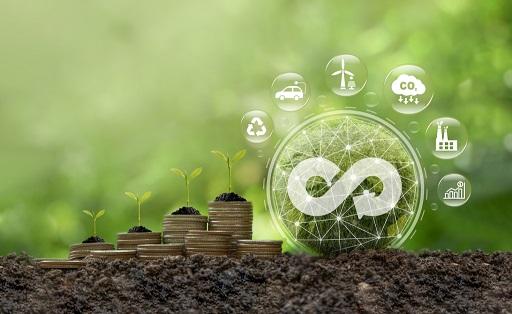
The concept of a “circular economy” was first mentioned in 1966 in the article “The Economics of the Coming Spaceship Earth” by the famous economist Kenneth Boulding. Later, in the research report “The Potential of Substituting Manpower for Energy” (1976), researchers Walter Stahel and Geneviève Rede of the European Commission explained the vision of the circular economy, its impact on job creation, economic competitiveness, and resources. A comprehensive definition is that a circular economy is an economy that aims to eliminate waste and pollution throughout the life cycles of materials. Countries such as the Netherlands, France, Italy, Germany, Luxembourg, Belgium, Portugal, and Spain are among the most widely implemented.
Today’s climate emergency and environmental challenges are forcing companies and individuals to rethink their production and consumption patterns, and one of the answers to these challenges is the circular economy. The main macro arguments in favor of a circular economy are that it can increase economic growth without increasing the burden on natural resource extraction, while decoupling resource use from economic welfare development for a growing population and reducing dependence on foreign countries for critical materials. It reduces waste generation. It introduces new production and consumption patterns that can create more value. Corporate arguments in favor of a circular economy are that it can secure the supply of raw materials.
Circular Economy – A plan to improve
The circular economy has four main components: using fewer natural resources, reducing pollution, combating climate change, and improving consumer satisfaction. The Ellen MacArthur Foundation recently outlined the economic opportunities of a circular economy. In line with this, the circular economy will contribute to reaching the COP (Conference of Parties) 21 Paris Agreement. The emission reduction commitments made by 195 countries in the COP 21 Paris Agreement are not sufficient to limit global warming to 1.5 °C. It is estimated that additional emissions reductions of 15 billion tonnes of CO2 per year will need to be achieved by 2030 to meet the 1.5 °C ambition. In 2018, the World Economic Forum, the World Resources Institute, Philips, the Ellen MacArthur Foundation, the United Nations Environment Programme and more than 40 partners launched a platform to accelerate the circular economy. PACE (Partnership to Advance Clean Energy) is a coalition of CEOs and ministers. It seeks to boost circular economy innovation. The original purpose of PACE had three central areas: (1) developing models of blended finance for circular economy projects, particularly in emerging and developing economies; (2) developing policy models to address specific barriers to advancing the circular economy; (3) promoting public-private partnerships for these purposes. In 2020, PACE released a report on the participatory circular economy, stating that the circular economy in the world accounts for 8.6%.
Digital Circular Economy
Circular business model innovation, digitalization, digital technologies, e.g., the Internet of Things, big data, artificial intelligence, building on blockchain, are considered key elements to boost the circular economy. The central role of digital technologies in accelerating the circular economy transition is emphasized in the Economy Action Plan of the European Green Deal. It allows various digital circular economy strategies to be assessed at their level of relevance, providing guidance on how to leverage data analytics to maximise circularity. In support of this, the recently published Horizon 2020 Project Model for a Circular Economy places digital technologies at the heart of several key innovation areas, such as waste management, industrial co-existence, and product identification.
Circular Economy – India
A circular economy in India is estimated to bring in annual benefits of Rs 40 lakh crore by 2050. It would reduce greenhouse gas emissions by 44%, along with a significant reduction in pollution. Sustainable growth is key to an Atmanirbhar Bharat. A development model that leads to optimum use of resources is needed. With a growing population, rapid urbanization, climate change, and environmental pollution, India must move towards a circular economy. This emphasizes the need to take a holistic view of products and processes. Production systems must adopt practices around circular economy principles so that they not only reduce resource dependency but also gain competitiveness. A circular economy, as adopted by India, could bring in significant annual benefits, including a significant reduction in congestion and pollution. This will have a multi-faceted impact on the economy. The ability to increase resource efficiency will encourage our transformation towards new business models, while reducing resource consumption.
The government is actively formulating policies and promoting projects to move the country towards a circular economy. It has already notified various regulations in this regard like Waste Management Rules, E-Waste Management Rules, Metals Recycling Policy etc. NITI Aayog has also taken up several initiatives to ensure sustainable economic growth. Direct initiatives have been taken to address the challenges of using waste as a resource and to create a vision for the recycling industry in India. NITI Aayog has also organized an international conference on ‘Sustainable Growth through National Recycling’.
The pandemic has exposed the gaps in the concept of development in global markets. India now needs to rely on a circular economy by focusing on the benefits for the people. It has been five years since the pandemic broke out worldwide. During this period, the world has fought bravely and collectively to meet this challenge. It further emphasized the need to build for the future through collective action, including self-reliance in industries, technology and digital investments, equitable growth, addressing imbalances in demand and supply, and addressing climate change. Close cooperation is required for a resilient and low-carbon economic recovery. With 2 percent of the world’s land area and 4 percent of its fresh water resources, the linear economic model of ‘take-make-dispose’ constrains India’s manufacturing sector and, consequently, the entire economy. Therefore, it is essential to identify and revolutionize the flow of goods in the manufacturing process and shift towards a circular economy that delivers multifaceted economic and environmental benefits.











